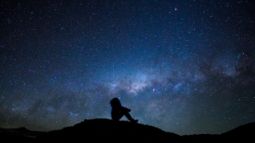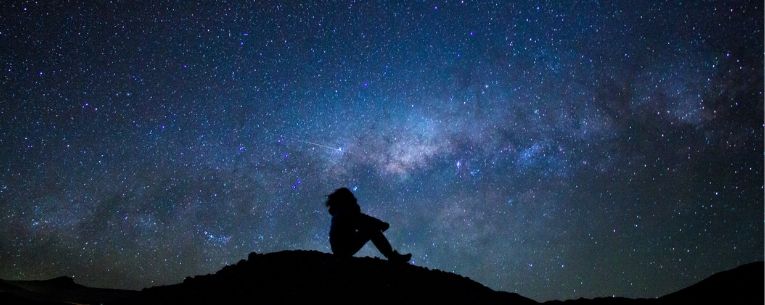Astrotourism isn’t the brain child of innovator Richard Branson or a Jetson’s intergalactic family getaway.
In fact, you’ve probably participated in some sort of astrotourism. If you’ve walked outside on a clear night somewhere in a remote destination, and curiously stared up at illuminated objects located light years away, then you’re experiencing astrotourism! Yes, stargazing is one of the most popular and accessible forms of astrotourism, as well as traveling to soak in a once-in-a-lifetime eclipse or chasing that picture-perfect meteor shower.
According to John Barentine of the International Dark-Sky Association, “Astrotourism is any kind of tourism that involves the night sky or visiting facilities related to astronomy like observatories, and combining that with a broader sense of ecotourism where interaction with nature is what the visitor experience is about.”1
We like the condensed version: astrotourism is about looking up at the sky and appreciating the natural world around you. Heck, you don’t even need to be outside to do it.
But you do need darkness, and in an age where more of our constellations and other out-of-this-world phenomena are obscured by growing light population — that’s an overabundance of artificial light — it’s harder and harder to find. Before we tell you the prime destinations to follow shooting stars, let’s talk a bit more about why stargazing and astrotourism have both risen up the charts in travel popularity over the past several years.
Why Is Astrotourism Getting So Popular Now?
Here is the thing about stargazing: technically, you don’t need to travel anywhere to scan the skies for your favorite constellation or aim your telescope at the international Space Station when it’s passing by your longitude and latitude. Right?
Well, that once was the case. You see, in order to experience the most ideal conditions for otherworldly sightseeing, you need darkness. And a lot of it. As cities grow and suburban sprawl expands, our world is more lit up than ever. The result is light pollution — covering some 80 percent of the earth including 99% of the skies in America and Europe — which obscures our views of what’s happening beyond our blue planet. Here’s an unfun fact, for the 80 percent of North Americans, the only Milky Way they can see is the candy bar. The galaxy itself is no longer visible above them.2, 3
To sum it up, your back yard probably isn’t the best spot to show your kid the Big Dipper. Consequently, areas that are off the beaten path, unplugged, or simply making a conscious effort to keep it dark are becoming increasingly popular destinations for those who want to see constellations shining brightly or search the skies for high-flying anomalies. We’ll provide some examples of astrotourism itineraries to plot out down below.
Another reason for the spike in astrotourism is the aftereffect of the 2017 solar eclipse, when an estimated seven million people traveled to and through America to be in its path. It was a party with solar shades and daytime darkness that sparked new possibilities for both travelers and destinations with a unique window into the skies above.2
Also don’t discount the impact of photo-sharing apps — who won’t “Like” an Aurora Borealis selfie? Nor can you rule out the effect that looming private space tourism has on getting folks excited about the world above. Suffice to say, when it comes to all the reasons why astrotourism and stargazing are on the rise, the stars have certainly aligned.3
Where to Go Stargazing, Eclipse Watching and More
In general, anywhere outside the reach of glowing skyscrapers, digital billboards, and thousands of porch lights clustered together is an ideal astrotourism destination. From there, there are a number of ideal locations for soaking in the night sky — and the natural world around you.
- Countries and Regional Destinations: These unplugged hotspots are attracting traveling stargazers thanks to both sheer desolation and astrotourism-friendly amenities.
- Chile: Not only does this South American nation claim the cleanest skies, but also a lion’s share of the world’s high-powered, astronomical telescopes. Areas to visit include San Pedro De Atacama’s, boasting arid deserts and many observatories, as well as Elqui Valley, where you can pair a glass of Syrah made from the vineyard behind your B&B with a clear view of what’s been classified as the world’s first international Dark Sky Sanctuary.4
- The Southwest (United States): When it comes to escaping light pollution in the United States, the drier and more deserted, the better. So, it makes sense that spots including Flagstaff, Arizona, the Grand Canyon, and New Mexico’s Cosmic Campground — where the nearest artificial light is more than 40 miles away — all make the list.2, 5
- Yellowknife, Canada: You’ll often hear of travelers stalking the Aurora Borealis, commonly known as the Northern Lights, through Scandinavia, New Zealand and Alaska. Instead, try Canada’s Northwest Territories on for size. This area benefits from low light pollution and just the right latitude. The ideal time to view this natural light show — generated when the particles charged by the sun get stuck within our magnetic field — is August through April, giving you a solid viewing window.6
- Rooms With a View: So you have a big-picture destination in mind. But where are you going to stay — and how can your accommodations elevate the astrotourism experience? If you’re heading to Iceland, check in at Hotel Rangá, where they’ll take the top down on a roll-off roof so that guests can step up to one of two astronomical telescopes for stargazing. (It’s also a great spot to trace the Northern Lights through the sky.)7 For another otherworldly experience, head to Australia’s Outback and book a room at the Ayers Rock Resort – Sails in the Desert Hotel, where the Great Outdoors welcome you with open-air BBQs, as well as telescopes and binoculars provided to admire and learn about the Southern Cross.8
The list of astrotourism landing spots doesn’t end there. Stargazing tours, cruises and other experiences are popping up with regularity. And if you want to DIY a getaway far away the bright lights of big cities, simply consult the International Dark-Sky Association’s Dark Sky Places program, which does the legwork of certifying parks, reserves, sanctuaries and other locations — some of which we’ve identified in this article.9
Just remember: when you’re off the grid and in the dark in brand-new destination, peace of mind comes in just as handy as night vision binoculars. Find an Allianz Travel Insurance plan to fit your stargazing trek — and be sure to download the Allyz® app in case you get lost in the stars (or simply want to consult your travel insurance plan).
More and more travelers are eyeing astrotourism and stargazing as the impetus behind their next trip. Maybe the goal is as simple as capturing the ultimate Instagram selfie against the distant yet radiant glow of Cassiopeia. Or perhaps the itinerary is camping with the family atop an inactive volcano while intently staring through a $1,000 telescope. That’s the beauty of astrotourism — there’s an entire constellation of getaway possibilities.
Related Articles








Share this Page